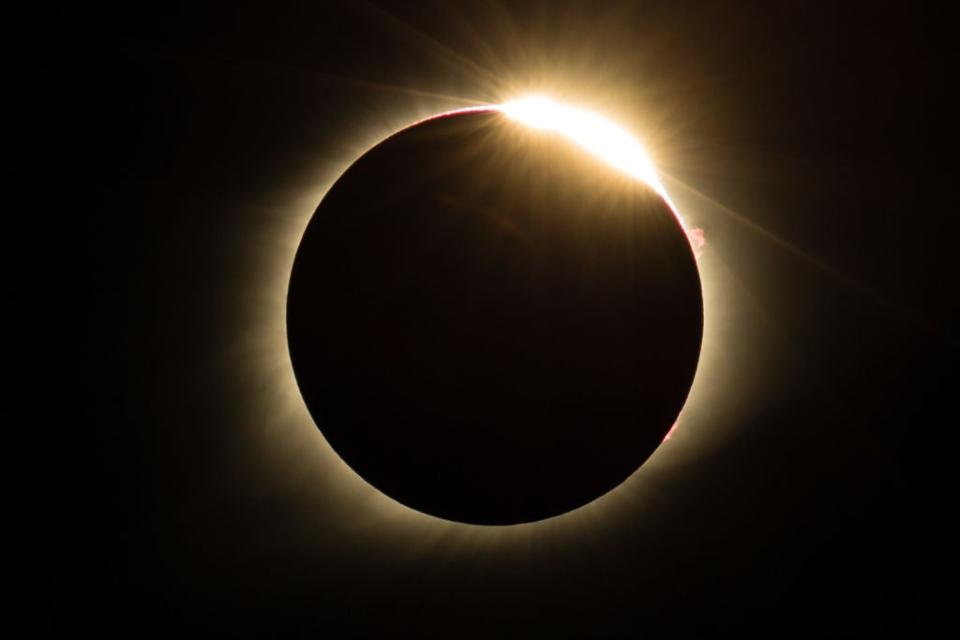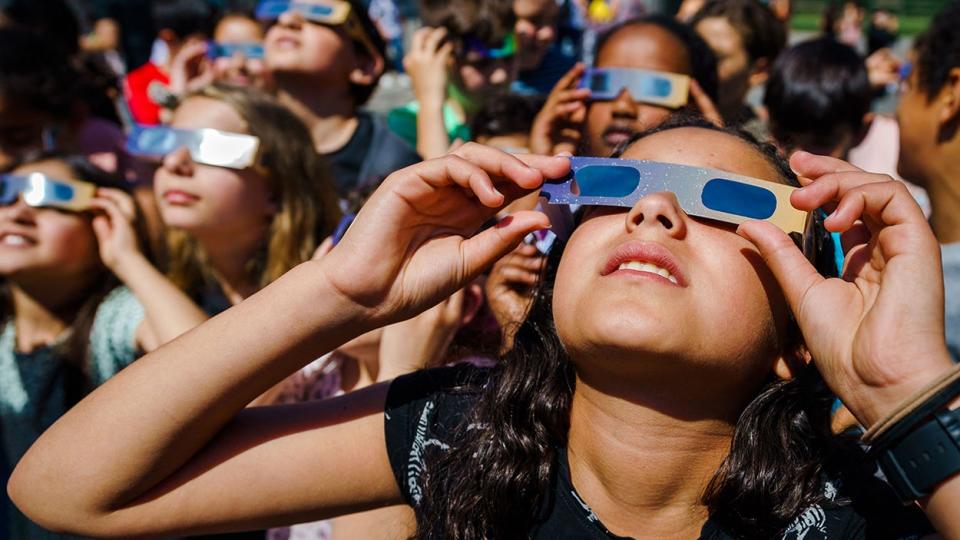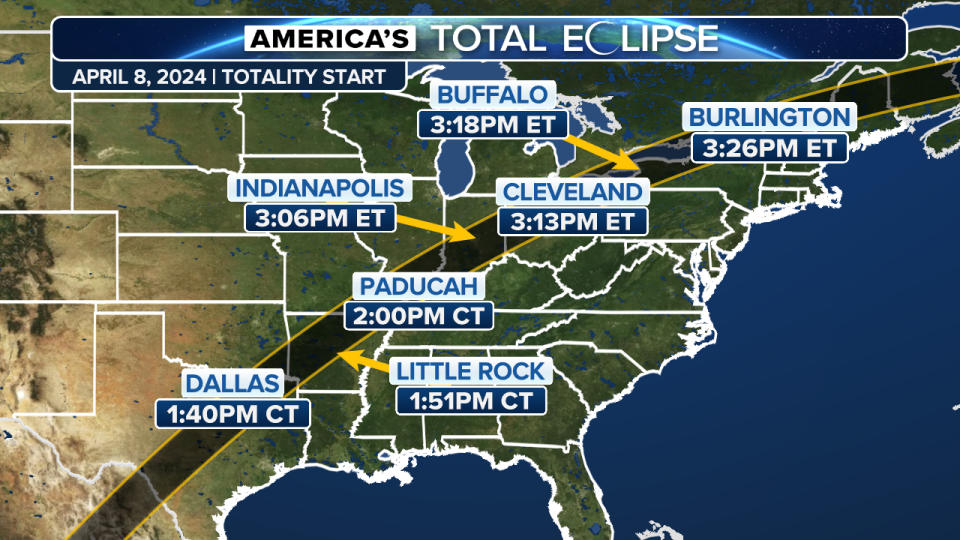Total eclipse caused 30% rise in fatal crashes in 2017, data shows

Officials urge travelers to drive defensively ahead of Monday's total solar eclipse. Many fear a repeat of the 2017 total solar eclipse when fatal car crashes rose by more than 30%.
Scientists looked at National Highway Traffic Safety Administration fatal crash numbers from the day before, the day of and the day after the total eclipse across the U.S. They found 741 people were involved in fatal crashes during those three days. That is a 30% increase compared to similar three-day periods before and after the August 21, 2017 celestial event.
About 10.3 people per hour were involved in a fatal crash, according to researchers.
The report authors wrote, "This averaged to 1 extra crash-involved person every 25 minutes and one extra crash fatality every 95 minutes."
AMERICA'S TOTAL SOLAR ECLIPSE HAS MILLIONS ACROSS US AWAITING ONCE-IN-A-LIFETIME EXPERIENCE

Traffic risks were comparable to highly traveled holidays like Thanksgiving, Memorial Day and the Fourth of July weekend.
"The findings likely derive from increases in traffic," rather than the eclipse itself, wrote the authors. "Other potential factors include travel on unfamiliar routes, speeding to arrive on time, driver distraction by a rare celestial event, drug- or alcohol-induced impairment from eclipse-related celebrations, and eclipse viewing from unsafe roadside locations."
NOAA estimated that 88% of all U.S. adults watched the solar eclipse in 2017. According to the authors, a third of all Americans lived within 300 miles of the path. About 20 million people in the U.S. traveled to see the eclipse, creating "substantial road traffic."
NOAA and NASA claim the 2024 eclipse will be more spectacular. The path of totality will be wider, 108–122 miles, compared to 62–71 miles in 2017.
LIVE COVERAGE: TOTAL SOLAR ECLIPSE APRIL 2024 – FOLLOW THE PATH ACROSS NORTH AMERICA
"The 2024 eclipse path will also pass over more cities and densely populated areas than the 2017 path did. This will make it easier for more people to see totality," wrote NASA. "An estimated 31.6 million people live in the path of totality this year, compared to 12 million in 2017. An additional 150 million people live within 200 miles of the path of totality."
That puts at least a partial solar eclipse within reach of 99% of those living in the U.S.
HERE'S WHAT NOT TO DO DURING THE TOTAL SOLAR ECLIPSE

The 2024 eclipse will also last longer. Carbondale, Illinois, boasted the longest time in totality, which was 2 minutes 42 seconds. Viewers will be in complete shadow at the Texas/Mexico border for 4 minutes and 26 seconds.
The Sun is also in a more active phase of the solar cycle. In 2017, it was nearing a solar minimum, which NASA said was why the Sun was quiet. Streamers flowing into the solar atmosphere were limited to the Sun's equator.
"During the 2024 eclipse, the Sun will be in or near solar maximum, when the magnetic field is more like a tangled hairball. Streamers will likely be visible throughout the corona. In addition to that, viewers will have a better chance to see prominences – which appear as bright, pink curls or loops coming off the Sun," wrote NASA. "With lucky timing, there could even be a chance to see a coronal mass ejection – a large eruption of solar material – during the eclipse."
Several cities along the path of totality have already declared states of emergency or issued disaster declarations in anticipation of the throngs of sky-watchers flocking to the hundred-mile-wide shadow crossing 13 states.
North of Austin in Bell County, Texas, officials fear the population will explode by three times.
"Projections are for this influx of people to begin occurring as early as several days before April 8th, with an outmigration occurring in the few hours immediately following the eclipse this year," Bell County Judge David Blackburn stated during a news conference. "If these numbers manifest themselves, the strain that this will put on our infrastructure will be significant. Everything from our first responders, to our health care systems, to our fueling stations, to our highways, to our emergency management stations and more. All of these could be severely strained by the influx of people."
WHAT YOU NEED TO KNOW ABOUT APRIL'S TOTAL SOLAR ECLIPSE

Travelers Insurance doesn't want you to be a statistic. Chris Hayes, Transportation Risk Control Leader at Travelers, has a few tips to keep you safe:
Plan ahead. Give yourself extra time to get to your destination on April 8 and stay off the road during the eclipse if you can – not because of your driving, but because other drivers are likely to be distracted by it. If you are traveling, check traffic and plan your route before heading out, as higher volumes are anticipated in areas where the solar eclipse passes over.
Keep your phone off: If you are in the car during the eclipse, don’t record it or take photos while driving. If you wish to do so, pull off the road and go to a safe location, like a parking lot.
Practice defensive driving. If you are traveling to a location to view the eclipse or in an area where people are traveling to view the eclipse, exercise heightened awareness. Be aware of other drivers and pedestrians who may be more distracted than usual.
AAA also has a few ideas:
Keep your vehicle’s headlights on.
Put the sun visor down to block your view of the Sun.
Don’t wear eclipse glasses while driving.
Original article source: Total eclipse caused 30% rise in fatal crashes in 2017, data shows

